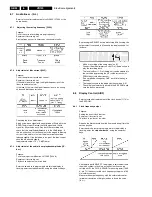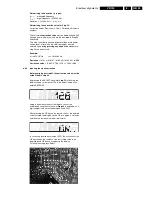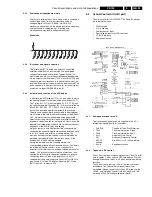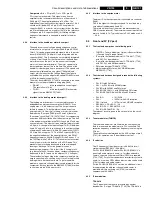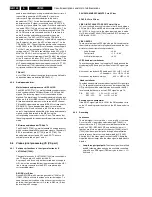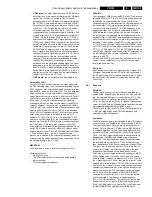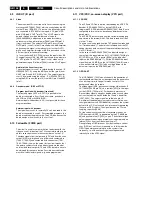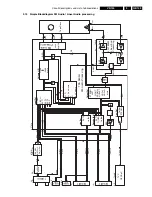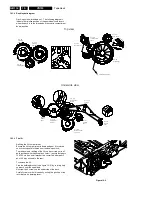
Circuit descriptions and List of abbreviations
GB 103
VR120
9.
•
Y-REC path: The video signal passes via a 3.5 MHz low
pass filter to vertical emphasis comprising the YNR block
(part of this circuit block is used in REC for vertical
emphasis) and a 1H-CCD delay line integrated into the
SE IC [7004-C] and an external emitter follower [7006].
This vertical emphasis can be switched via IIC and is only
active in LP. The Y-signal before the 1H-CCD can be
measured on pins 43 and 45 on the IC [7004-C]
(separated only by a coupling electrolytic capacitor). The
Y-signal after the 1H-CCD is passed back from pin 46 IC
[7004-C] via the E-follower [7006] on pin 41 IC [7004].
After the vertical emphasis the Y-signal passes via pin 21
[7004], the E-follower [7008] (the filter, on the base of the
emitter follower is not active in REC mode (due to the low
resistance of the output stage on pin 21 [7004]), via pin
21 [7004] and a clamping stage to the detail enhancer.
The Y-signal is then passed to the non-linear emphasis,
the linear emphasis (time constant via pin 18, 19 - due to
the low resistance of the pin 18 output stage and the
transistor [7010] introduced for impedance decoupling,
the FM PB all-pass does not influence the linear
emphasis) and the white/dark clipping stage. The signal
generated in this way then triggers the FM modulator
directly. The FM-Y-signal generated in this way is passed
via the REC-EQ filter and the REC-FM-AGC1 to the Y-C
addition point. The FM-Y-signal can be measured after
the REC-EQ filter on pin 12 [7004].
•
C-REC path: see Chrominance PAL Recording (6.2.2).
Chrominance PAL
The chroma signal is separated from the video signal after
the FBC clamping stage (see “Luminance recording“) by the
BPF1 band pass filter and reaches the ACC stage via a delay
element (D.E.) and a low pass filter (LPF). The ACC amplifier
stage controls the chroma amplitude for the subsequent
stages (time constant via capacitor [2038] on pin 14 [7004]).
The chroma signal is then conveyed to the main converter
(Main Conv.). The main converter mixes the 5.06MHz
subcarrier with the 4.43 MHz chroma signal to the 627kHz
chroma FM signal. The subcarrier is a mixture of 4.43MHz
(the REC APC time constant on pin 65 compares quartz and
burst frequency) and (40+ 1/8) fH = 627kHz (produced by
321fH -VCO corresponds to 8(40+1/8)fH, time constant pin
60/62 and phase rotation in accordance with the VHS
standard, 10 [7004] (CROT)). Via a low pass filter (C_LPF)
and the colour killer stage (KIL), the converted chroma signal
reaches pin 72 on the IC [7004], where it is added directly to
the Y FM signal IC internally via a capacitor [2007]. The
colour killer can either identify the incoming signal itself (PAL
yes/no, PAL: chroma signal out, SECAM L: chroma signal
killed) or be set via the I
2
C bus to PAL MESECAM or SECAM
L. The quartz oscillation (pin 66) is used for chroma
processing, in addition to the reference frequency, and also
for generating the pulse frequency for the combined CCD on
pin 49 integrated into the IC [7004].
MESECAM
The signal path is virtually identical to the path for PAL.
The differences are:
•
No phase rotation.
•
The filter characteristic for the chroma band passes
becomes wider.
•
Free-running quartz frequency
SECAM L
The video signal (VREC) from the SE IC pin 32 [7004] passes
through SECAM L SE IC pin 15 [7072] and a band pass filter
(4.3MHz BPF-A) and reaches the cloche filter (CA filter
components pin 21) which reverses the Hf pre-emphasis on
the sender side. The C-signal is then limited (LIM, time
constant pin 18) and divided to 1/4 of the frequency in the
frequency divider. The C-signal is suppressed in SYNC
GATE during the H-sync. period. The harmonics arising in
the division into four and the gating are suppressed in the
band pass filter (1.1MHz BPF) and then pre-processed in the
anti-cloche filter (filter components pin 8) for standard VHS
recording. The amplitude on the REC-chrome signal on pin
11 [7072] can be set using the setting resistor [3088] on pin
10 [7072]. This REC-chroma signal is passed via transistor
[7077] as a CSRP signal to SE IC pin 72 [7004] following an
external drop (3.9MHz, suppression of the 3
rd
harmonics of
the low frequency REC-chroma) and added to the FM-Y-
signal in the SE IC.
As the SECAM SE IC (LA7339A) has an automatic cloche
and anti cloche comparison, only the REC-chroma signal
level is required to be set.
FM signal
After the addition of the FM-Y-signal and the C-signal, this
FM-signal is adjusted by the REC-FM-AGC2 controlled by
the IIC bus to the preset amplitude (reference: pin 74 [7004]
resistor [3009]). The head pair is selected using the HSC
control line.
9.6.3
Playback
FM signal
The FM signal coming from the scanner is amplified by
approx. 60dB. Depending on the level of the HSC and HP1
line, the amplified FM signal is connected to pin 74 [7004].
The envelope curve signal for the head currently active
(TRIV) is output on pin 93 [7004]. In addition, the envelope
curves for the SP and the LP heads which read from the tape
are compared and output as the ENVC signal.
The FM signal (FMPV) on pin 74 [7004] is used internally for
Y, SECAM, MESECAM and NTSC M/N playback and
externally for SECAM playback.
Luminance
The FM playback signal is first adjusted in the AGC stage to
a constant level and filtered in the FM processing (PB-EQ).
The signal exits the IC [7004] on pin 18, passes via an E-
follower [7010] with drop (1.07MHz - only in SECAM units -
to suppress additional chroma remainders externally) to a
phase shifter [7003] and enters the IC once more on pin 17
[7004]. The FM-Y signal limited using the double limiter is
demodulated (FM-DEM) and filtered using a low pass
(SUB_LPF). The demodulated Y signal is also affected by
the recording-side pre-emphasis. This now removes the
linear de-emphasis at the base of the emitter follower [7008].
The filter circuit is effective, as pin 21 [7004] becomes an
open collector output in playback mode, where the load
impedance is determined by the de-emphasis circuit.
The Y signal is then clamped after the E-follower on pin 20
[7004], filtered using a low pass, and carried by a vertical
noise canceller or dropout compensator (Y.N.R.). To do this
the Y-signal exits the IC [7004] (out: pin 43, in: pin 41) and
delayed by 1H in the internal CCD. The CCD-1H delay line is
effective for the Y signal first as a comb filter (vertical noise
suppression) and secondly as a line storage device for the
dropout compensation. The subsequent switching stages
are: The non-linear de-emphasis (NON_LIN DE_EMP),
horizontal noise canceller (N.C.1 / N.C.2) and the picture
control switching to the increase in edge steepness
(PIC_CTL ANR; sharpness). The luminance signal is then
added to the chroma signal (Y/C MIX) and output (pin 29
[7004]) as FBAS signal via a clamp (FBC), the video input
(CHARA INSERT) and a 6dB amplifier (6dB_AMO).
Summary of Contents for VR570
Page 12: ...Direction for use GB 12 VR120 3 3 Direction for use RT111 RT116 RT112 RT114 RT123 RT121 RT128 ...
Page 15: ...Direction for use GB 15 VR120 3 SAT VR870L VR870CC VR720 Set width 435 mm ...
Page 56: ...Service modes Repair tips GB 56 VR120 5 Engineer s remarks ...
Page 79: ...Circuit diagrams and PWB layouts Wiring diagram 79 VR120 7 7 16 Wiring Diagram Motherboard ...
Page 81: ...Circuit diagrams and PWB layouts Wiring diagram 81 VR120 7 Engineer s remarks ...
Page 82: ...82 VR120 7 Circuit diagrams and PWB layouts Wiring diagram Engineer s remarks ...
Page 83: ...Circuit diagrams and PWB layouts Wiring diagram 83 VR120 7 7 18 Mother board component side ...
Page 119: ...Tape deck GB 119 VR120 10 ...
Page 123: ...Tape deck GB 123 VR120 10 Engineer s remarks ...






